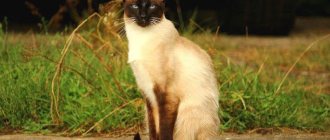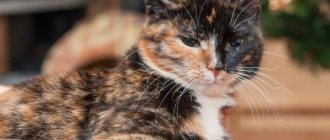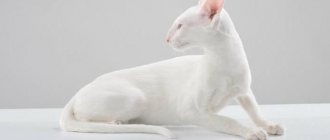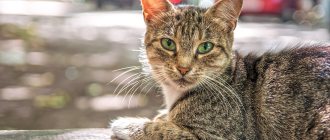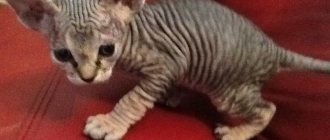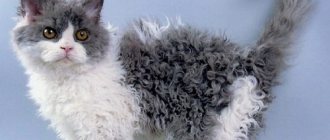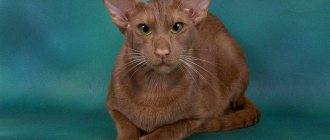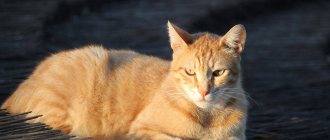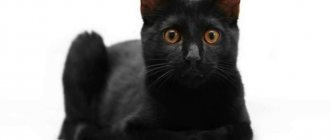Body type
The description of the Turkish Van breed should begin with its external data. Its representatives have semi-long hair, a rectangular back, which only barely becomes narrower the closer to the tail. These cats have well-developed paws. The hind ones are slightly shorter than the front ones.
These are quite large cats - length ranges from 90-120 cm, and weight from 4.5 to 9 kg.
The head is wedge-shaped, resembling a cut triangle. The ears are straight, slightly rounded at the ends.
Quite often there are representatives with heterochromia, that is, with eyes of different colors. It is believed that such animals are special, they carry some kind of mystery and intrigue. And they certainly arouse interest.
All the charms of the appearance of this breed can be seen in the photo of the Turkish Van cat.
History of the Turkish Van breed
Images of white-haired cats with fluffy tails were found on jewelry from the era of Urartu, a disappeared state that occupied the territory of the Armenian Highlands.
Modern felinologists consider Lake Van, which belonged to the possessions of ancient Armenia, and later passed to the Ottoman Empire, to be the birthplace of the breed. It was in the vicinity of this reservoir that catfish, called “wana katu,” bred uncontrollably for thousands of years, subsisting in fishing and mouse trapping. In the Middle Ages, cats from the banks of the Van entered Europe with the crusaders and caravans of merchants. The breed, however, did not win wide recognition in the Old World, but there a new name stuck to its representatives - ring-tailed cats. As for the modern history of the Vanir, it began in the middle of the 20th century, with the travel of the British journalist Laura Lushington. While traveling through the former Ottoman Empire, an Englishwoman received two kittens as a gift from local residents, which they presented as the indigenous Van Kedisi breed. The fluffy pets captivated the new owner because they discovered an insatiable craving for water and bathing, which is unusual for European cats. It is implied that this interesting feature prompted Lushington to return to Turkey again for an additional “batch” of cats, which later became the progenitors of all English Vans.
By 1969, Van Kedisi were bred in full force in Europe, and at exhibitions they were simply called Turkish cats. And only in 1971, after the animals were included in the FIFe lists, a more detailed name appeared - the Turkish Van cat. In 1979, the purr was recognized by TICA, and in 1994 by the CFA. But in Turkey, swimming cats were long refused to be considered as a unique breed, which did not stop local cat owners from keeping a whole litter of Vans.
Today, the import of animals from the Republic of Turkey has been officially stopped, and the cats themselves have been declared a national treasure. Sometimes, of course, exceptions are allowed, but this happens almost at the government level. So if you are not a significant political figure, like Bill Clinton, to whom the Turks presented the sacred Van cat in 1996, count on fluffies born within the walls of domestic, European and American catteries.
An interesting fact: in Turkey, only solid white individuals with heterochromia are praised, while felinological commissions treat this type of breed with caution.
And although the process of standardization of albino Vans has already been launched by several associations, at exhibitions animals with spots between the ears and a colored tail continue to be considered exemplary Van cats.
Color
The completely white Turkish Van has its own name - Vankedizi.
The standard is when a luxurious white coat has red-chestnut markings. The spots should be located on the muzzle under the ears, as well as on the tail and slightly on the back.
It is also possible to have black, blue and cream colored spots.
Wool
The length of the fur varies across the body. On the body it is shorter, in the tail it is longer (up to 5 centimeters). The issue of caring for a fur coat is quite simple - these cats do not require brushing, since they do not have a thick undercoat.
More mature individuals are fluffier than Turkish Van kittens. The length is also affected by the time of year. In winter the coat is longer. In the warm season, after molting, shorter hairs come to replace them.
Maintenance and care
There are no particular difficulties in caring for Van cats.
- Caring for the coat is easy - for a natural shine, it is enough to brush it once a week. During periods of intense shedding, brushing should be done once a day or two days. You can trim your nails from time to time. It is also important to check your pet's ears weekly for dirt or infection.
- Also important is cleanliness in the tray and easy, constant access to clean, fresh water.
- Turkish Vans need periodic walks in the fresh air and frequent active games.
Peculiarities
This breed is also sometimes called the Turkish Van water cat. This is explained simply. Among the purring four-legged animals, you don’t often meet those who are calm about water.
Vans love to swim. The structure of their coat helps them to tolerate contact with water calmly. The cashmere-feel of the wool is actually water-repellent.
Anatolian diseases
Nature has endowed Anatolian cats with healthy genetics and strong immunity. That is why representatives of the breed rarely suffer from serious diseases. The list of pet diagnoses can only be supplemented by common infectious or parasitic diseases that sometimes occur in all cats.
Thanks to good health, the age of pets can reach 15-16 years.
Conclusions about the Turkish breed
global $ads_google;
//data-ad-slot=”2475549904″ $ads_google = empty($ads_google) ? false : true; ?> if ($ads_google == false) {?> $ads_google = true; ?> } ?> The affectionate and intelligent Anatolian cat is loved not only in its historical homeland - in Turkey. She is one of the cat's favorites in Holland, Germany, and Greece. It is in these countries that the majority of nurseries are concentrated. In the CIS and the former USSR, in particular Russia, Belarus, and Ukraine, one of the best breeds is bred mainly by private breeders. The most important thing is that now you can easily buy a beautiful Anatolian cat , which at any period of life will bring joy and pleasure to its owner from communication.
Nutrition
The Turkish Van is a fairly large and restless cat. Her diet should be high in calories and should be based on meat and fish. Van will also be happy to eat dry food.
It is important to make sure that it is from a good manufacturer and, preferably, labeled “for active cats.”
Feeding
Turkish Vans are cats with an innate instinct of hunter and fisherman, so it is very important from childhood to accustom them to a calm, “civilized” diet from dishes intended only for them . If possible, attempts to obtain food independently should be prevented.
The best option for feeding Van cats is to use premium food with a suitable balance of vitamins and microelements necessary for an active and contented life for your pet.
It is worth choosing ready-made food for active cats with additional protein and carbohydrate content. A varied menu will guarantee that the cat will be full after lunch and will not go hunting “on the side.”
From natural food, Van cats should be given, of course, fish. It is better to use well-cooked sea fish, boned and seafood.
Cats should be completely excluded from their diet: sweets, chocolate, salty and smoked foods, citrus fruits.
You should not overfeed your Van cat, which never refuses supplements. She doesn't need obesity or metabolic disorders.
Price
The Turkish Vap is not a cheap breed. This is explained by the fact that they are quite rare and indigenous. The price of a Turkish Van cat depends a lot on its color.
If the owner buys a cat for the soul, and not for exhibitions, then appearance does not matter much, because even completely white Vans have the main advantages of their character.Pure white individuals are considered a kind of marriage and do not carry any value as purebred specimens. However, they can become the most loyal and affectionate pet.
Health
Native cat breeds have strong immunity. No diseases to which snow-white murkas would be predisposed have been identified.
However, vaccination and prevention of parasites is a mandatory procedure. In addition, regular checkups with your veterinarian are important. Even if your cat looks healthy, it should be seen by a doctor at least once a year. This will help prevent possible illnesses and prolong the life of your pet.
